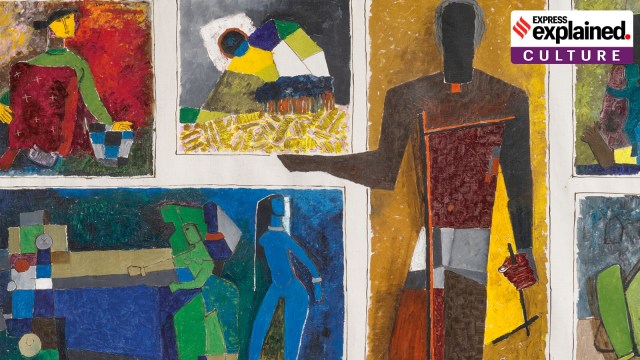From Delhi to Oslo, story of M F Husain’s painting that has been sold for a record Rs 118 crore
The monumental artwork was bought in 1954 by a Ukrainian-Norwegian doctor, and was displayed for decades in a private corridor in a hospital in Oslo. What is this painting, and what does it show?
 'Untitled (Gram Yatra)', a monumental oil-on-canvas measuring nearly 14 feet x 3 feet, comprises 13 vignettes. (Photo: Christie’s)
'Untitled (Gram Yatra)', a monumental oil-on-canvas measuring nearly 14 feet x 3 feet, comprises 13 vignettes. (Photo: Christie’s)A hitherto largely unknown Husain was sold for $13.8 million (more than Rs 118 crore) at a Christie’s auction in New York on March 19, becoming the most expensive Indian artwork to be auctioned, and the first to cross the Rs 100-crore mark.
‘Untitled (Gram Yatra)’, a monumental oil-on-canvas measuring nearly 14 feet x 3 feet, comprises 13 vignettes that appear as a celebration of rural life in India.
It had remained in the collection of Oslo University Hospital, Oslo for several decades, largely away from the public eye. How did the painting travel to Norway; what is the story of its ‘rediscovery’ and sale?
Story of the painting
Husain painted the work in 1954, and displayed it that same year at an exhibition titled ‘M F Husain and Krishen Khanna’ at the All India Fine Arts & Crafts Society (AIFACS) in Delhi.
In the city at the time was Leon Elias Volodarsky (1894-1962), a Ukrainian-born surgeon based in Norway. Dr Volodarsky was the head of a World Health Organisation (WHO) team that was helping to establish a thoracic surgery training centre in the capital of the newly independent nation.

An avid art collector, Volodarsky would often visit museums and art galleries in India. He reportedly bought the painting from Husain for his home in Oslo.
In 1964, Dr Volodarsky’s estate donated the painting to the collection of Oslo University Hospital, where it was exhibited in a private corridor, mostly hidden from public view.
Some 13 years ago, the existence of the painting was brought to the attention of Nishad Avari, Head of the Department, Indian Art, at Christie’s.
Avari told The Indian Express that this was the most significant Indian artwork that he had brought to auction. “The last few years have seen very sustained growth patterns for prices of Indian art. As stronger works come out in the market, there is room for this trend to expand further,” he said.
The painting garnered almost four times its high estimate of $3.5 million. Prior to last week’s sale, the most expensive work of Indian art to be sold at an auction was Amrita Sher-Gil’s 1937 ‘The Story Teller’ that fetched $7.4 million (Rs 61.8 crore) at a Saffronart auction in India in 2023.
The work, its significance
The canvas belongs to a critical period for Indian art and in the career of M F Husain.
The first decade after Independence was a time of intense artistic development in the country. Young Indian artists were striving to establish a modern artistic idiom that was distinct from both revivalist nationalism and colonial academic realism.
The Progressive Artists’ Group, which led the way in the creation of an Indian avant garde, was established in Mumbai in 1947. Husain (1915-2011) was a founding member, along with S H Raza (1922-2016), F N Souza (1924-2002), K H Ara (1914-85), H A Gade (1917-2001), and the sculptor S K Bakre (1920-2007).
Through the 1950s, Husain produced several of his seminal works, including the iconic ‘Zameen’ (1954-55), which is now in the collection of the National Gallery of Modern Art in New Delhi.
His modernism was deeply rooted in India, and is in evidence in the 1954 work sold last week. Its 13 vignettes include varied scenes from village life – a man and a woman riding a bullock cart, a woman dancing with a drummer, another woman pounding wheat, etc.
An open field rendered with expressive brushstrokes was ostensibly inspired by Husain’s visit to China in 1952, where he was impressed by the calligraphic strokes; another landscape shows a more fragmented cubist approach.
Evolution of Husain’s art
The young Husain used art as a means to express himself, and would often ride his cycle into the countryside around Indore to paint landscapes.
On one such trip, he met the renowned painter N S Bendre, who recognised his talent and suggested to his father that he should be given formal training in art. During his brief academic stint at the Lalit Kala Sansthan in Indore, Husain realised he could compete with those ahead of him in art college.
In the 1930s, Husain arrived in Mumbai, and famously spent his initial years in the city making a living as a cinema-hoarding painter who was paid four or six annas (about 25-36 paise) per square foot. He later joined a furniture shop called Fantasy, where he designed nursery furniture and wooden toys for children, and received a steady income of Rs 25 per month.
Husain was reportedly offered admission to Mumbai’s J J School of Art in the mid-1930s, but was unable to join the famed institution. He sold his work directly to collectors for modest sums, and held his first major public show in 1947, when he displayed his ‘Sunehra Sansar’ at the annual exhibition of the Bombay Art Society.
In subsequent decades, Husain would become one of the best known faces of Indian art, taking his work all over India and to several countries abroad.
He merged modernity and tradition, drawing inspiration from diverse sources from cubism to temple sculptures to miniatures. He used bold colours and thick brush strokes, and his recurring subjects included horses, lamps, deities, and epics such as the Mahabharata and Ramayana.
Husain’s subjects and mediums changed constantly, and he went from small paper works to gigantic murals, printmaking, photography and later, even filmmaking.
While his work received wide acclaim, it also provoked anger among some who saw his art as insulting to Hindu deities and the motherland. Husain received multiple death threats, and hundreds of cases were registered against him. He finally left India on self-imposed exile in 2006, and accepted Qatari citizenship in 2010. While still in exile, he passed away in London in 2011.
More Explained
Must Read
EXPRESS OPINION
Mar 28: Latest News
- 01
- 02
- 03
- 04
- 05



























